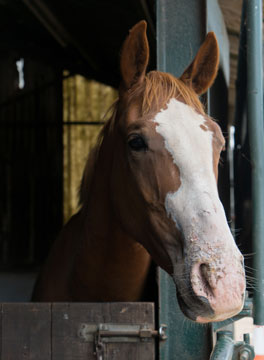Whilst a seemingly non-invasive and quick approach to diagnosis, the strangles blood test does not always give a definitive answer. Confirming the presence of antibodies induced by Streptococcus  equi equi bacteria (the causative agent), this assures an exposure to strangles within the last six months; it is not necessarily indicative of a current infection. Consequently, follow up investigation is always recommended for positive blood tests regardless of the result owing to a weak 90.9% sensitivity of disease detection via blood test.
equi equi bacteria (the causative agent), this assures an exposure to strangles within the last six months; it is not necessarily indicative of a current infection. Consequently, follow up investigation is always recommended for positive blood tests regardless of the result owing to a weak 90.9% sensitivity of disease detection via blood test.
The steps taken following blood tests vary according to test outcome as well as owner’s preference. But what method achieves the most definitive confirmation of a strangles diagnosis?
If the blood test is positive, your vet will advise isolation and a guttural pouch lavage. The guttural pouch is a cavity within the horse’s head that can harbour and hide bacteria; this means that horses may carry strangles bacteria without showing disease signs.
A guttural pouch lavage is the most effective way of diagnosing the presence of strangles bacteria. Here, a saline solution is passed through the nostril and into the guttural pouch cavity via an endoscope. As a result, this allows potential bacteria from the cavity to be identified and can confirm or deny a strangles infection.
If the blood test is negative, your vet will still advise 2-3 weeks isolation before introduction to new herd and recommend a repeat blood test in two weeks. Strangles can take up to two weeks succeeding infection to induce antibody production. Therefore, if your horse had been infected by strangles in the few days preceding the first blood test, the test will still show as negative. A second blood test post two weeks isolation helps to provide confirmation as to whether your horse carries Streptococcus equi equi bacteria.
If your test shows as negative however your horse is showing clinical signs of strangles, your vet will recommend a guttural pouch lavage (as described earlier). Clinical signs include: high temperature, loss of appetite, yellowish nostril discharge, enlarged glands in head and neck, coughing and difficulty swallowing. It could be the case that your horse is simply carrying bacteria within the guttural pouch that are ‘hiding’ in the cavity from an immune response.
Written by Georgia Nunn, a recent 3rd year vet student from the University of Glasgow.
This article is part of our August 2019 equine newsletter.
You can read the full newsletter here.
